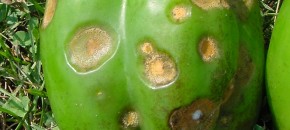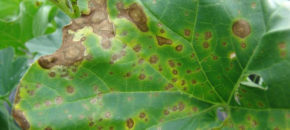Protectant (contact) fungicides, such as the inorganics (copper, FRAC group M01) and sulfur (FRAC code M02); the dithiocarbamates (mancozeb, M03), phthalimides (Captan, M04), and chloronitriles (chlorothalonil, M05) are fungicides which have a low chance for fungicide resistance to develop. Protectant fungicides typically offer broad spectrum control for many different pathogens. Why wouldn’t fungi develop resistance […]
Continue reading...Understanding The Differences Between FRAC Group 11 and FRAC Group 3 Fungicides
FRAC Group 11 Fungicides The strobilurin, or QoI fungicides (FRAC group 11) are extremely useful in controlling a broad spectrum of common vegetable pathogens. You may know some of strobilurins as azoxystrobin (Quadris), trifloxystrobin (Flint), pyraclostrobin (Cabrio), or Pristine (pyraclostrobin + boscalid, 11 + 7). For example, FRAC group 11 active ingredients such as azoxystrobin […]
Continue reading...Preparing for Pepper Anthracnose

In recent years, pepper anthracnose caused by Colletotrichum spp. has become a significant problem on some farms in southern New Jersey. Unlike in tomato, where symptoms are only present in mature (red) fruit, pepper anthracnose can infect pepper fruit at any growth stage. Currently, there are no commercially-available bell or non-bell peppers with known resistance […]
Continue reading...Anthracnose and Alternaria Leaf Blights in Cucurbit Crops

Anthracnose and Alternaria leaf blight can become problematic in cucurbit crops during long periods of wet, humid weather. Both can cause significant losses if not controlled properly. With the production season quickly approaching, now is a good time to review a few of these important diseases. […]
Continue reading...Avoid Sunscald Injury in Transplants
Now that the weather is beginning to cooperate and temperatures are warming up, be cautious about sunscald developing on the stems of transplants, especially those being set onto black plastic mulch. With a little planning ahead potential losses to sunscald injury can reduced significantly. A transplant coming straight out of the greenhouse and directly into the […]
Continue reading...Protect Your Farm Workforce Now!
The threat of COVID-19 infecting one of your employees is real. The impact on your business could be devastating. A news report from North Carolina just confirmed the first case of a seasonal farm worker testing positive for the virus there. It can happen here just as easily, unless you are proactively helping your workers […]
Continue reading...